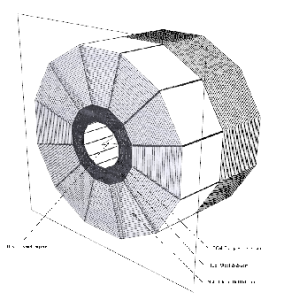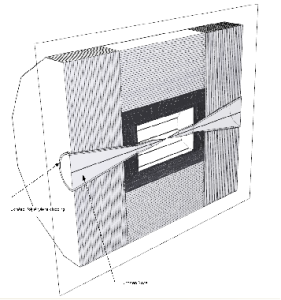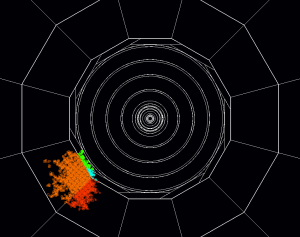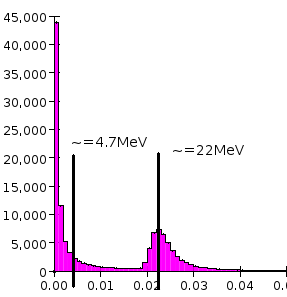I'm Alexander Conway, a 4th year undergraduate at the University of Chicago and have been working with the muon collider group at Fermilab to do preliminary R&D on a possible detector design. You can find me at my Confluence page.
This page serves to document my work done with timing studies on the mcd00 detector model using the org.lcsim Java library, JAS3 analysis software and AIDA plotting tools.
It will be useful for anyone wanting to learn how to use these tools for timing studies or extend any work I have done. Please let me know if you find this page useful.
For more information on the Muon Collider, see the MCPDS Confluence page, slides from the June, 2011 Muon Collider Conference, and Fermilab's Muon Collider page
(Please note; this page will soon be moved within display/MCPDS, the Muon Collider Physics and Detector Simulation home page)
Overview
The scope and focus of my work is described in more detail ?here (PDF).
The Muon Collider Physics and Detector Simulation group is in the beginning stages of research and development for a potential muon accelerator-collider. I am doing preliminary studies on a potential design for the calorimeter. My work so far has used a very simple and unrealistic detector model, mcd00, to evaluate the potential of this sort of design by examining the effects of timing cuts and clustering algorithms on energy resolution and response using Monte Carlo simulated single-particle events. Future work will focus on developing techniques for physics event reconstruction and noise rejection.
Detector Design
The basic concept for a detector that we want to build is an active, non-sampling, depth segmented calorimeter. The Muon Collider will have the advantage of being a lepton collider, allowing for precise measurements of any new physics discovered at the LHC. There will be an unprecedentedly large background from muons decaying in the beam which will make these precise measurements more difficult, so reducing it is of great importance.
The noise from muon beam decays is closely correlated with beam crossings, on the order of nanoseconds, meaning precise, high resolution timing will be critical for reducing the background. Many approaches are being considered, but we believe that calorimeters with small cubic segmentation and high timing resolution will be critical for achieving the required energy resolution.
Depth segmentation gives a very good view of shower development and allows for time of flight corrections to block out noise. Being totally active gives the energy response and resolution necessary for the elimination of confused events and other useful calorimetry techniques, while also being useful for particle flow algorithms.
mcd00
Rendering of mcd00, created by Norman Graf for the 2011 Muon Collider Conference at Telluride, Co.
|
EM |
Hadronic |
Muon |
|---|---|---|---|
Material |
Tungsten |
Steel235 |
Iron |
Cell seize (cm^3) |
1 |
2 |
10 |
# of Layers |
10 |
40 |
30 |
Depth (cm) |
10 |
80 |
300 |
Radiation Length (g/cm^2) |
6.76 |
13.9 |
13.8 |
Radiation Length (cm) |
6.35 |
16.8 |
16.8 |
mcd00 is a totally active, depth-segmented, nonsampling calorimeter. It consists of a silicon tracker, a homogeneous tungsten electromagnetic calorimeter, a homogeneous steel hadronic calorimeter and an iron muon chamber, all immersed in a 5 Tesla solenoidal magnetic field.
Future versions of the detector will have crystal calorimeters, give cerenkov photon readout in addition to ionization energy and have different geometry, but mcd00 is useful as a preliminary look at this type of detector to inform future designs.
Calorimetry
Because of the importance of precise timing and high energy resolution, the most fundamental factor to look at is the speed of shower development. If an idealized detector model is physically unable to meet the requirements then there is little point in moving forward with the design. With this in mind, I started my analysis with single particle Monte-Carlo simulations of 10GeV electrons and pions leaving the interaction point perpendicular to the beam, with no noise.
Sample 10GeV Pion Event in WIRED4 Event Display
This screenshot of the WIRED4 Event Display in JAS3 shows a sample event from the pion data sample from a beam's eye perspective. Most of the shower is in the hadron calorimeter and there is noticeable 'splashback' from energy reflected from the surface of the calorimeter. The splashback hits have very low total energy.
Time-of-Flight
All times used in calculations for this study are corrected for time of flight. In the ideal case, the shower deposits energy at a time very close to the time it would have taken a photon to travel from the interaction point to that calorimeter cell. The time of flight correction subtracts r/c, the radial distance from the interaction point divided by the speed of light to find the corrected time t'. Integrating the energy deposition as a function of t' can tell us what sort of time window is necessary to detect a sufficient amount of energy.
Energy Response and Resolution for 10Gev Electrons (pink) and Pions (green)
Table of Selected Values
|
Mean Energy Response (GeV) |
|
RMS (GeV) |
|
RMS/?E |
|
|---|---|---|---|---|---|---|
|
Electrons |
Pions |
Electrons |
Pions |
Electrons |
Pions |
10ns |
9.94 |
7.48 |
0.04 |
0.86 |
1.3% |
27% |
100ns |
9.95 |
7.76 |
0.03 |
0.72 |
1% |
23.7% |
100ns |
9.95 |
8.25 |
0.02 |
0.58 |
0.6% |
18% |
These plots show respectively the mean energy response and resolution of the detector with respect to integration over greater and greater windows over t'. The electrons make small showers that are mostly contained by the electromagnetic calorimeter. They are very 'fast' and have high resolution. Pions tend to have a more significant time delay in their showers, likely due to nuclear interactions and non-linear paths. They also vary much more widely in their absolute energy response as the pions lose energy in nuclear interactions.
Making Cuts
The analysis so far has included all hits from all areas of the calorimeter. In a realistic scenario it will never be possible to attribute splashback showers to the original particle. Only the hits in the primary shower will be included in the calorimeter's energy measurement and these will be identied primarily using clustering techniques. In addition there will be an energy cut made to eliminate responses from detector noise, so this must be estimated and simulated as well.
Clustering
The org.lcsim framework includes two clustering algorithms. The first is nearest-neighbor clustering, which groups hits located within a specified number of cells from each other. The second is fixed-cone clustering, which groups hits that fall within a cone originating in the interaction point and optimizes itself to find the cone directions that give the greatest energy response. I begin by testing these out on pion and electron samples.
Nearest Neighbor and Fixed-Cone Clusterers With 10GeV Pion.
Energy Response and Resolution for Nearest Neighbor Clusterer
|
Mean Energy Response (GeV) |
|
RMS (GeV) |
|
RMS/?E |
|
|---|---|---|---|---|---|---|
|
Electrons |
Pions |
Electrons |
Pions |
Electrons |
Pions |
10ns |
9.51 |
6.15 |
0.087 |
1.65 |
2.8% |
52.2% |
100ns |
9.52 |
6.20 |
0.086 |
1.15 |
1.6% |
36.4% |
100ns |
9.52 |
6.27 |
0.085 |
1.14 |
2.6% |
36.0% |
Energy Response and Resolution for Fixed-Cone Clusterer
|
Mean Energy Response (GeV) |
|
RMS (GeV) |
|
RMS/?E |
|
|---|---|---|---|---|---|---|
|
Electrons |
Pions |
Electrons |
Pions |
Electrons |
Pions |
10ns |
9.94 |
7.34 |
0.087 |
0.91 |
2.8% |
28.8% |
100ns |
9.94 |
7.57 |
0.052 |
0.83 |
1.6% |
26.2% |
100ns |
9.93 |
7.90 |
0.083 |
0.77 |
2.6% |
24.4% |
For the electron dataset, neither algorithm has a significant effect on energy response or resolution, which is unsurprising due to the compact nature of electron showers.
With pions the difference is more noticeable. The fixed cone clusterer performed best because pion showers often had components separated from the main shower deeper in the calorimeter. The nearest neighbor algorithm had a 52.2% RMS/?E at 10ns, suggesting that much of the energy from pions is often deposited in several locations. However the drop in mean response over time was negligible, so it is perhaps possible to reconstruct these showers more accurately in a relatively short time window.
The nearest neigbor cluster has a similar, slightly lower mean and a slightly higher RMS, but overall the two algorithms are very similar. This is likely to change when the algorithms are applied after energy cuts are made.
More sophisticated analyses will combine clustering with many other techniques to separate and measure showers so refining the performance of these clusterers is not yet relevant. This study has provided a better picture of what is possible with these algorithms.
Energy Cuts
One way to reduce noise is to cut cell hits below a certain energy. This will also eliminate some amount of signal, so it is important to see how these cuts might affect energy resolution and response.
Minimum Ionizing Particle (MIP)
Muons approximate a minimum ionizing particle, depositing only the physical lower bound on the amount of energy a relativistic charged particle can deposit in a particular substance. In order to detect these muons it will be necessary to be able to identify calorimeter cells with this minimal ionization energy. Any absolute energy cuts must be below this value, so I must measure this MIP energy and generate a cut below that. This energy cut requirement is somewhat arbitrary, but it provides a reasonable estimate for a possible cutoff.
I use a 10Gev muon data set much like the pion and electron samples and look at the energy deposited in each cell. Looking at sample events in the event viewer, it is clear that the muons do indeed make a trail of MIP energy deposits as they travel through the calorimeters.
Energy Deposition Per Cell in Muon Calorimeter - 10 GeV Muons
A 5MeV cut was made in the EM calorimeter based on this plot. The low energy hits come from ionization in cells through which the muon only passed a small distance, the peak is the minimum ionizing energy deposition. We used about 1/5 of the MIP energy to define our energy cut.
Single 10GeV Pion Shower With Energy Cuts.
|
Mean Energy Response (GeV) |
|
RMS (GeV) |
|
RMS/?E |
|
|---|---|---|---|---|---|---|
|
Electrons |
Pions |
Electrons |
Pions |
Electrons |
Pions |
10ns |
9.51 |
6.74 |
0.059 |
0.88 |
2.1% |
27.8% |
100ns |
9.51 |
6.85 |
0.064 |
0.82 |
2.0% |
26.0% |
100ns |
9.52 |
7.05 |
0.067 |
0.75 |
1.9% |
24.0% |
This cut affects the early shower the least, bringing the energy response from 7.50GeV to 6.74GeV at 10 ns but leaving the RMS/?E essentially unchanged at 27%. The later part of the shower is aected much more, bringing the 8.25GeV response at 1000ns down to 7.05 GeV and bringing the RMS/?E from 18% to 24%. This implies that the early portions of the shower have a very similar per-cell energy distribution while the later shower varies much more.
Predictably, the clusterers performed worse when applied to the cut data. The nearest neighbor algorithm lost the most energy and had the worst RMS/?E, 52% at 10 ns and 36% at 100 and 1000 ns. The fixed cone algorithm lost less energy and had an energy resolution nearly identical to when it was applied to the full dataset. The nearest neighbor lost so much energy because it only added hits within three cells of the central cluster, whereas the fixed cone was large enough to capture more hits from the non-contiguous clusters.
Conclusions
Again, while fine-tuning these algorithms is possible, there is little point. These studies have been a good introduction to org.lcsim and the detector. For example it suggests that hard energy cuts might eliminate too much signal and that other particle characterization techniques will have to be used. It is still unknown whether this is a feasible detector design, but this study suggests that with an optimized calorimeter and the development of advanced reconstruction techniques it may provide the response and resolution we need.
Further studies will examine physics events and attempt reconstruction, which will use some of the information learned here and will use an updated detector which will have updated geometry and materials. This detector model will be a dual-readout calorimeter, reporting Cerenkov photons in addition to ionization energy and use crystals with similar radiation lengths as the materials used here.








